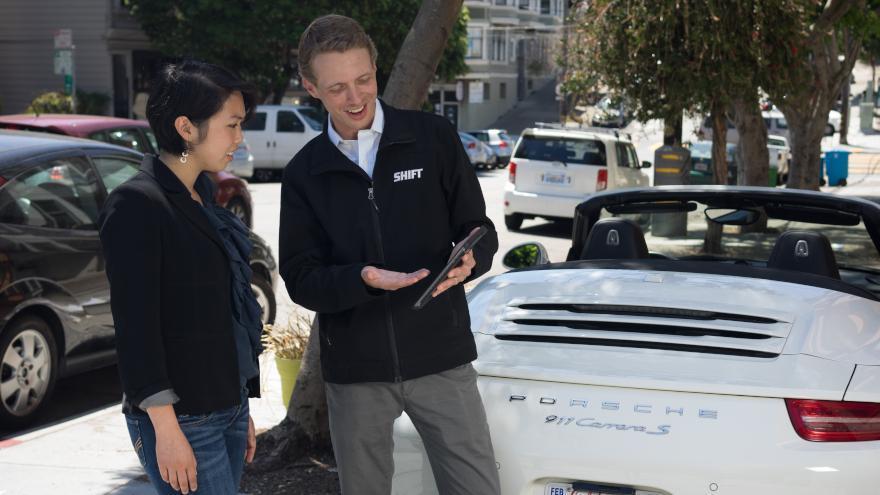Lithia and Shift to operate separately and share technology

Shift test-drive image courtesy of company.
MEDFORD, Ore. -
Lithia Motors and Shift Technologies will continue to operate separately, but their recently announced partnership creates a wide range of synergies, said Lithia president and chief executive Bryan DeBoer.
Lithia is keenly interested in Shift’s used-vehicle procurement technology, which is key to both companies’ growth strategies, DeBoer said.
Shift, based in San Francisco, is a digital marketplace that facilitates the buying and selling of used vehicles for consumers.
“When we think about (Lithia’s) used-car business, the major driver of being able to improve sales as well as margins is to be able to procure vehicles and what Shift will have the ability to do someday — which they are doing a nice job at — is procuring vehicles at a very rapid rate,” DeBoer told analysts and reporters during the company’s third-quarter earnings conference call on Oct. 24.
“And I think, as we start to use their technology or look into those opportunities, our stores will be able to do that.”
The companies announced Lithia’s $54 million investment in Shift in September. Shift operates in California and expects to sell 8,000 used cars and trucks in 2018.
In mid-October, Lithia helped Shift secure a credit line for acquiring used-vehicle inventory that is quadruple its previous floorplan credit line. The move also gives Shift the ability to scale to over $1 billion in revenue.
“They’re (Shift’s leadership) is now looking at how they scale, and to which markets they’re going to be going into first, and that’s the key to ramping up that inventory,” DeBoer said.
Lithia.com has a vast online used-vehicle inventory, and its traffic has increased 33 percent over the prior year, he said.
“This partnership will further the in-home vehicle purchasing, selling and servicing experience and leverage our nationwide network that currently reaches over 80 percent of consumers in the country,” DeBoer said. “Together, we are focused on furthering our retail experience to allow customers to shop wherever, whenever and however they desire.”
Buying, selling dealerships
In the quarter that ended Sept. 30, Lithia sold seven dealerships DeBoer described as “poor performing locations,” added one dealership location and separated two franchises into separate facilities, DeBoer said.
The retail auto industry is unconsolidated with the 10 largest dealership groups owning less than 8 percent of all new-car dealerships in the U.S., he said.
At the end of October, publicly-held Lithia operated 182 dealership locations. It completed over $2 billion in dealership acquisitions over the last year and is still on the look-out for stores, DeBoer added.
“We continue to monitor over 2,600 acquisition targets and remain primed to seize opportunities that meet our strict return on equity hurdles and round out our national footprint,” he said.
In the quarter, Lithia’s net income soared 79.4 percent to $93.1 million. When adjusted for gains on dealership dispositions and tax benefits and for expenses related to acquisitions and storm insurance revenues, the company’s net income rose 25 percent to $69 million.
The company’s third quarter revenues of $3.1 billion was 15.4 percent more than the year-ago quarter.
Lithia’s overall new-unit sales increased 7.3 percent in the quarter to 48,790; overall average gross profit per new unit in the quarter grew 6.8 percent to $2,068.
On a same store basis, new unit sales dropped 5.1 percent to 40,974, and average gross profit per new unit was up 4.2 percent to $2,016.
Used: Units sales up; gross profits down
Lithia’s overall used-unit sales were up 14.5 percent to 39,751, and overall average gross profit per used vehicle sold dropped 4.1 percent to $2,172.
On a same-store basis, used-unit sales increased 2.8 percent to 34,434, and average gross profit per used vehicle sold slid 1.7 percent to $2,256.
According to Chris Holzshu, Lithia executive vice president, on a same store basis:
- *Lithia sold 68 used vehicles per store, per month, up from 67 per store, per month, in the year-ago quarter. The company’s used-to-new vehicle sales ratio was 0.84 to 1.
- sales of the company’s core used vehicles increased 10 percent; sales of its value used vehicles increased 5 percent and sales of CPO units declined 3 percent. Lithia describes its CPO vehicles as 3 years old and newer; core vehicles as 3 to 7 years old and value autos are eight years and older.
- service, body and parts revenue increased 3 percent. Customer pay service and parts work represents over half of that revenue stream and increased 5 percent; warranty work revenue increased 1 percent; wholesale parts revenue decreased 1 percent and body shop revenue decreased 5 percent.
About F&I
Also on a same store basis, Lithia arranged financing on 72 percent of the vehicles it sold, sold a service contract on 46 percent and sold a lifetime oil product on 24 percent, Holzshu said.
F&I revenue by store location, ranges from $600 to $2,500 per vehicle with Lithia’s “seasoned stores” averaging about $1,500 per vehicle and “unseasoned stores” averaging about $800 per vehicle, he said.
“It gives us a real opportunity to continue to focus on the upside potential of more F&I growth,” Holzshu added.

 View The Latest Edition
View The Latest Edition

